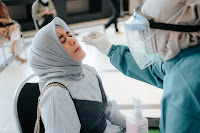H1N1 influenza, referred to as swine flu, is a highly contagious respiratory disease in pigs caused by one of several swine influenza A viruses, as recently reviewed. Transmission of swine influenza viruses to humans is uncommon. However, the swine influenza virus can be transmitted to humans via contact with infected pigs or environments contaminated with swine influenza viruses.
Symptoms
The signs and symptoms of flu caused by the H1N1 virus are similar to those of infections caused by other flu strains and can include:
Fever, but not always
Chills
Cough
Sore throat
Runny or stuffy nose
Watery, red eyes
Body aches
Headache
Fatigue
Diarrhea
Nausea and vomiting
Flu symptoms develop about one to three days after
you're exposed to the virus
How does H1N1
flu spread?
The CDC believes that this H1N1 virus is spread in the same way that seasonal flu spreads. You could catch the flu directly from droplets from the cough or sneeze of an infected person, or by touching an object they recently touched, and then touching your eyes, mouth, or nose.
What should I do if someone I live with has confirmed H1N1 flu?
Limit your contact with the affected person.
Avoid close contact such as kissing, and do not share towels, glasses or toothbrushes with the affected person.
Avoid having visitors.
If visitors must enter the home, they should avoid close contact with the affected person.
Wash your hands with soap and water or with an alcohol-based hand rub.
Drink plenty of water
Risk factors
If you live in or travel to an area where many people are infected with the H1N1 virus, you may be exposed to the virus.
There are antiviral medicines you can take to prevent or treat swine flu. There is a vaccine available to protect against swine flu.
You can help prevent the spread of germs that cause respiratory illnesses like influenza by
How is
H1N1 flu treated?
H1N1
flu is sensitive to the antiviral drugs Tamiflu and Relenza. The CDC recommends
those drugs to prevent or treat swine flu; the drugs are most effective when
taken within 48 hours of the start of flu symptoms. But not everyone needs
those drugs. Most people who have come down with H1N1 flu have recovered
without treatment.
H1N1 SWAB
TEST (THROAT SWAB)
The back of the throat near the tonsils. Nasal / Nasopharyngeal Swab: Insert dry swab into nostril and back to nasopharynx. Leave in place for a few seconds. Slowly remove swab while slightly rotating it.









0 Comments